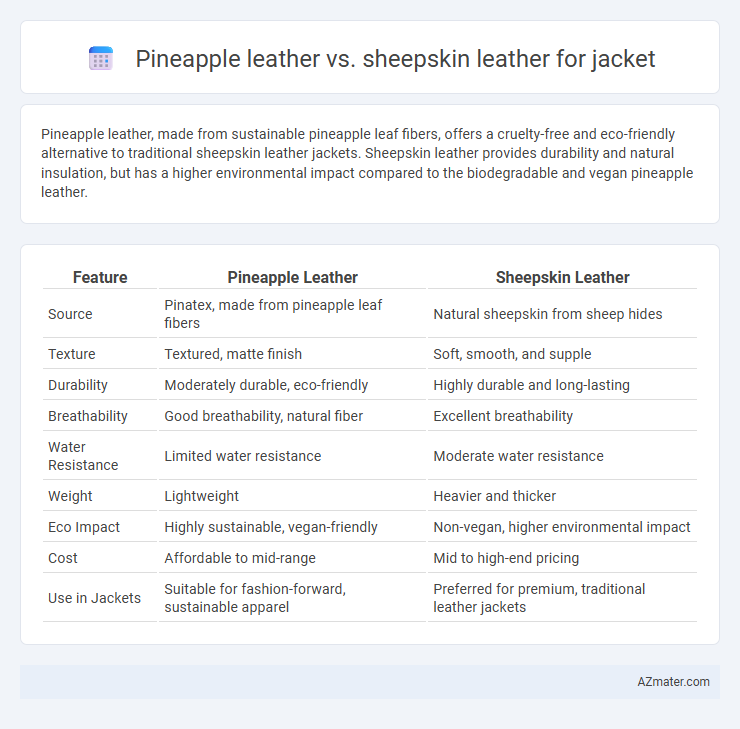Pineapple leather, made from sustainable pineapple leaf fibers, offers a cruelty-free and eco-friendly alternative to traditional sheepskin leather jackets. Sheepskin leather provides durability and natural insulation, but has a higher environmental impact compared to the biodegradable and vegan pineapple leather.
Table of Comparison
| Feature | Pineapple Leather | Sheepskin Leather |
|---|---|---|
| Source | Pinatex, made from pineapple leaf fibers | Natural sheepskin from sheep hides |
| Texture | Textured, matte finish | Soft, smooth, and supple |
| Durability | Moderately durable, eco-friendly | Highly durable and long-lasting |
| Breathability | Good breathability, natural fiber | Excellent breathability |
| Water Resistance | Limited water resistance | Moderate water resistance |
| Weight | Lightweight | Heavier and thicker |
| Eco Impact | Highly sustainable, vegan-friendly | Non-vegan, higher environmental impact |
| Cost | Affordable to mid-range | Mid to high-end pricing |
| Use in Jackets | Suitable for fashion-forward, sustainable apparel | Preferred for premium, traditional leather jackets |
Introduction to Pineapple Leather and Sheepskin Leather
Pineapple leather, derived from the fibers of pineapple leaves, offers a sustainable and eco-friendly alternative to traditional animal leather. Sheepskin leather, sourced from sheep hides, is known for its softness, durability, and natural insulating properties, making it a classic choice for high-quality jackets. Both materials provide unique benefits--pineapple leather emphasizes environmental sustainability while sheepskin leather highlights comfort and longevity.
Material Origins and Sustainable Sourcing
Pineapple leather, derived from pineapple leaf fibers through the innovative Pinatex process, represents a sustainable alternative by utilizing agricultural waste that reduces environmental impact compared to traditional leather production. Sheepskin leather, sourced from the hides of sheep, is a natural animal-based material often linked to livestock farming practices that raise concerns regarding resource usage and animal welfare. Pineapple leather's plant-based origin and eco-friendly sourcing practices provide a renewable and cruelty-free option, whereas sheepskin leather relies on conventional animal agriculture with a higher carbon footprint.
Manufacturing Process Comparison
Pineapple leather, also known as Pinatex, is crafted from pineapple leaf fibers, which undergo a decortication process to extract cellulose, followed by eco-friendly treatments and coating with a TPU layer to mimic traditional leather texture. Sheepskin leather involves a tanning process starting with raw hides subjected to liming, fleshing, tanning (often chrome or vegetable-based), and finishing to enhance durability and softness. The pineapple leather manufacturing emphasizes sustainability through agricultural waste utilization and lower chemical usage, whereas sheepskin leather relies on animal byproducts and more resource-intensive chemical processing.
Environmental Impact and Eco-Friendliness
Pineapple leather, derived from the agricultural waste of pineapple leaves, offers a sustainable alternative to traditional sheepskin leather by significantly reducing animal exploitation and minimizing deforestation. The production process of pineapple leather typically involves fewer harmful chemicals and generates less carbon emissions compared to the resource-intensive and methane-producing livestock farming required for sheepskin. Choosing pineapple leather jackets contributes to lower environmental footprints through renewable resource use and biodegradable end products, enhancing eco-friendliness without compromising durability or style.
Durability and Longevity of Both Leathers
Pineapple leather, made from sustainable Pinatex fibers, offers moderate durability with a unique texture but generally wears faster than traditional animal leathers. Sheepskin leather is renowned for its softness and excellent durability, often lasting many years due to its natural strength and ability to resist wear and tear. For jackets demanding long-lasting performance, sheepskin leather provides superior longevity compared to pineapple leather alternatives.
Comfort, Texture, and Wearability
Pineapple leather offers a lightweight, breathable texture that enhances comfort, making it ideal for warmer climates and extended wear. Sheepskin leather provides a soft, supple feel with natural insulation properties, ensuring warmth and durability in colder conditions. While pineapple leather excels in eco-friendly breathability and flexibility, sheepskin leather stands out for its long-lasting wearability and classic texture.
Jacket Maintenance and Care Requirements
Pineapple leather, made from sustainable plant-based fibers, requires gentle cleaning with a damp cloth and mild soap to maintain its texture and prevent cracking, avoiding harsh chemicals and prolonged sunlight exposure. Sheepskin leather, known for its softness and durability, demands regular conditioning with leather-specific products to prevent drying and cracking, along with prompt removal of stains using appropriate leather cleaners. Both materials benefit from air drying away from direct heat sources to preserve their appearance and prolong jacket lifespan.
Aesthetic Appeal and Fashion Trends
Pineapple leather offers a unique, eco-friendly texture with a slightly matte finish that appeals to sustainable fashion enthusiasts and aligns with current trends toward plant-based materials. Sheepskin leather, known for its soft, supple surface and natural sheen, remains a classic choice favored for its luxurious appearance and timeless elegance in fashion. While pineapple leather suits bold, modern statement pieces, sheepskin leather continues to dominate in traditional, high-end jacket designs.
Cost Comparison: Pineapple Leather vs Sheepskin Leather
Pineapple leather, derived from sustainable Pinatex fibers, typically costs 20-30% less than traditional sheepskin leather, making it a budget-friendly alternative for jackets. Sheepskin leather offers a natural softness and durability but involves higher processing expenses, driving up prices significantly. Consumers seeking eco-friendly options benefit financially from pineapple leather's lower manufacturing and material costs.
Which Leather Is Better Choice for Jackets?
Pineapple leather offers a sustainable and cruelty-free alternative to traditional sheepskin leather, characterized by its lightweight and breathable texture, making it ideal for eco-conscious consumers. Sheepskin leather provides superior durability, natural insulation, and a soft, supple feel, ensuring long-lasting comfort and protection in jacket construction. The choice depends on priorities: pineapple leather suits vegan and environmentally-focused buyers, while sheepskin leather remains the preferred option for those valuing durability, warmth, and traditional leather aesthetics.

Infographic: Pineapple leather vs Sheepskin leather for Jacket
 azmater.com
azmater.com